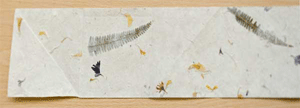I went to the "Festival of Quilts" at the NEC last weekend, while I was in Penarth visiting my parents. Knowing that anything I bought would have to fit in my case to be brought home via the London Underground, I had no intentions of buying anything.
But fabric is so much more compact than yarn!
I bought a 3 metre piece of lovely cotton with the plans to make a new skirt and top set. That is the floral piece in the background.
|
Then I saw this stunning hand dyed fabric. Very expensive but soooooooo gorgeous. It is made by Farbstoff. The lady was lovely and spent ages helping me find the right colours. Originally I was looking for a pice to photograph my work on but I ended up getting two pieces, the second one to make jewellery stands with. |

|
Yes, I know they are going to work out very expensive jewellery stands but I need something special for when I finally get around to designing the silk jewellery.
I used a template I found online. Stella & Hodge show you how to make some simple stands that fold flat. They make theirs from card. The template is perfect for what I wanted to do. I just wanted them posher.

| I had also bought some very thick interfacing at the show. I went stash diving and found the Bondaweb and then I was ready. |
| As interfacing doesn't score and bend like card, I cut one full piece. The second piece was trimmed just inside the dotted lines of the template so that the pieces didn't touch. |

|

| Finally, fold the hem over, sew a single line of stitching from the back to hold it all in place. Then a decorative row just inside from the front. |
I only had enough interfacing for 3 stands so bought some iron-on interfacing to make the other two. It was no where near as thick so I used three layers to build it up. This way worked out a lot cheaper than the using the thicker interfacing and Bondaweb, it just meant more cutting out to do.
If I make any more, I would just use one layer for the full template and build up the strength in the separate pieces. This will give a much sharper fold line and make them sit better. I would also use thinner ribbon and magnetic catches in stead of having to ties bows each time.
Now all I have to do is design the silk jewellery to display on them.





































